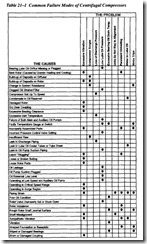PNEUMATIC SYSTEM COMPONENT fAILURE MODES
Each of the components that make up a pneumatic system has inherent design strengths and weaknesses. A thorough understanding of these inherent characteristics will be helpful in your troubleshooting efforts.
Compressors
Compressors can be divided into three classifications: centrifugal, rotary, and reciprocating. This section identifies the common failure modes for each.
Centrifugal Compressors
The operating dynamics of centrifugal compressors are the same as for other centrifu gal machine trains. The dominant forces and vibration profiles are typically identical to pumps or fans. However, the effects of variable load and other process variables (e.g., temperatures, inlet/discharge pressure) are more pronounced than in other rotat ing machines. Table 21-l identifies the common failure modes for centrifugal com pressors.
Aerodynamic instability is the most common failure mode for centrifugal compres sors. Variable demand and restrictions of the inlet air flow are common sources of this instability. Even slight variations can cause dramatic changes in the operating stability of the compressor.
Entrained liquids and solids can also affect operating life. When dirty air must be han dled, open-type impellers should be used. An open design provides the ability to han dle a moderate amount of dirt or other solids in the inlet air supply. However, inlet filters are recommended for all applications, and controlled liquid injection for clean ing and cooling should be considered during the design process.
